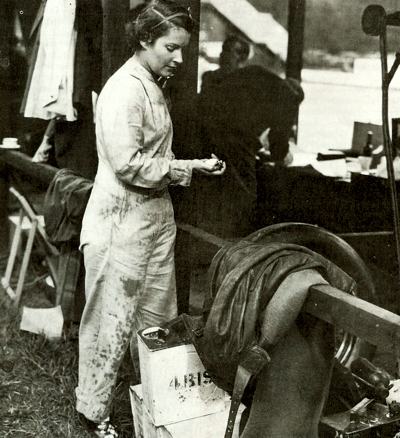Arguably The Greatest Female Driver of All Time
One of the most glamorous pioneering race drivers of all time was Canadian born British racer Mrs Kay Petre, whose petite appearance concealed a steely determination to win, and which made her one of the outstanding racing drivers on the British scene in the 1930s. Kay Petre started racing with sports cars, and during 1935 was one of an all-girl team at
Brooklands, along with Aileen Ellison and Mrs Tolhurst.
At the time,
Sammy Davis commented: 'A distinctly decorative appearance and turnout disguised a toughness, and tenacity, that was as unexpected as it was magnificent. If she had orders to hold a certain speed, or drive so many hours, all creation could not have stopped her doing it, whether a large car at 130 mph or a small one at 90 mph was involved. This had been most noticeable in two Monte Carlo Rallies where she had been one of the crew, for on each occasion she lasted through the three days and four nights of driving without turning a hair.'
Quite apart from her track performance, you could not help noticing Kay Petre: in July 1936, she arrived for her first Donington meeting in the 'luxurious magnificence' of a huge
Morris in concours condition painted in the same livery as her supercharged
Riley. The press recorded: 'Mrs Petre made a fine start, but was outmatched for the nonce.' The following week, the elegant Kay was on her way to take part in the Ramsgate Concours d'Elegance. She had already earned a place in Brooklands history, lapping in the big 10.5-litre V12 Delage at almost 135 mph, the second-fastest speed at Brooklands achieved by a lady driver (the fastest was Gwenda Hawkes, whose time in the Derby-Maserati equalled virtually 136 mph).
The Austin Works Team
The 1937 season saw Kay Petre as one of the official Austin works team, driving a side-valve Austin racer, while Dodson and Hadley handled the new ohc cars. The team's first official outing was the 1937 British Empire Trophy meeting at Brooklands, but all three were forced to retire, Kay Petre's car developing accelerator trouble. However, the cars appeared again a few weeks later at Shelsley Walsh, where the Austin team carried off all the honours in the 750cc class, making the first, second, third, fourth and fifth fastest times. Kay Petre's time of 46.9 seconds, fourth fastest in the class, was especially noteworthy compared with Bert Hadley's new class record, as Hadley was piloting the new ohc model, and Kay Petre's car was the side-valve.
Later the same month (June), the Austin team lineup was Hadley (ohc), Goodacre (ohc) and Kay Petre (sv). The supercharged Austins were scratch cars, giving 40.5 minutes to H. B. Shaw (Salmson), who completed 25 laps before Hadley was allowed to start. Hadley's stint included a new 750cc class record lap of 121.68 mph, and by the time Goodacre took over, the team had come from the back of the field to fifth place. Goodacre turned in consistent lap speeds of 118 mph, so that when Kay Petre set off, after 70 laps, the team was lying second.
On the 50th lap, though, the oil gauge on her car's dashboard suddenly began to leak scalding hot oil into the cockpit of the Austin as she was in the lead. Regardless of the discomfort, Kay Petre held on to the lead with lap speeds of 100 mph-plus, expecting all the while that the engine would seize from lack of oil pressure. However, her luck held, and the Austin team won the relay with an overall average of 105.63mph, 15mph faster than the record held by Morgan since 1934, and well ahead of the second team, MG, who averaged 85.8 mph.
 Kay Petre at Brooklands in 1935. She was to become one of the most famous women drivers of all time and established herself as a serious and competitive performer.
Kay Petre at Brooklands in 1935. She was to become one of the most famous women drivers of all time and established herself as a serious and competitive performer.
|
Austins Le Mans Debut
On 13 June 1937, Kay Petre was one of the works team which gave Austin their Le Mans debut, but the unblown Jamieson-modified cars suffered from teething troubles, and failed to figure in the results (although, rebodied, they subsequently enjoyed considerable acclaim in trials and rallies under the new name of Grasshopper). It was as the Grasshopper that these cars were entered for the 12-hour race at Donington that year, taking second, third and fifth places, the latter position falling to Kay Petre and her co-driver P. Stevenson.
In the Crystal Palace Cup on 15 August, plug trouble spoiled Kay Petre's chance of coming second in the Is-lap Crystal Palace Cup, but at Shelsley Walsh a month later, she climbed the course in 43.78 seconds to earn the Ladies Challenge Trophy. While practicing for the Brooklands BRDC 500 miles event that month, Kay Petre was travelling at 90 mph when her car was struck by Reg Parnell's MG, which had been travelling too high up the banking. The little Austin rolled, and Mrs Petre was taken to hospital with severe concussion.
Thereafter, she devoted herself to writing about motoring for the Daily Sketch, but here, too, tragedy struck, as in the 1939 Monte Carlo Rally, she and Major Reggie Empson were following the competitors through France when their car was hit by a truck at a crossroad; Empson was killed and Kay Petre was injured. However, she continued her career after the war, becoming one of the first members of the Guild of Motoring Writers. Much later, she designed fabric patterns for the interior of the Mini and was a motoring journalist. She died in 1994, at the age of ninety-one.



